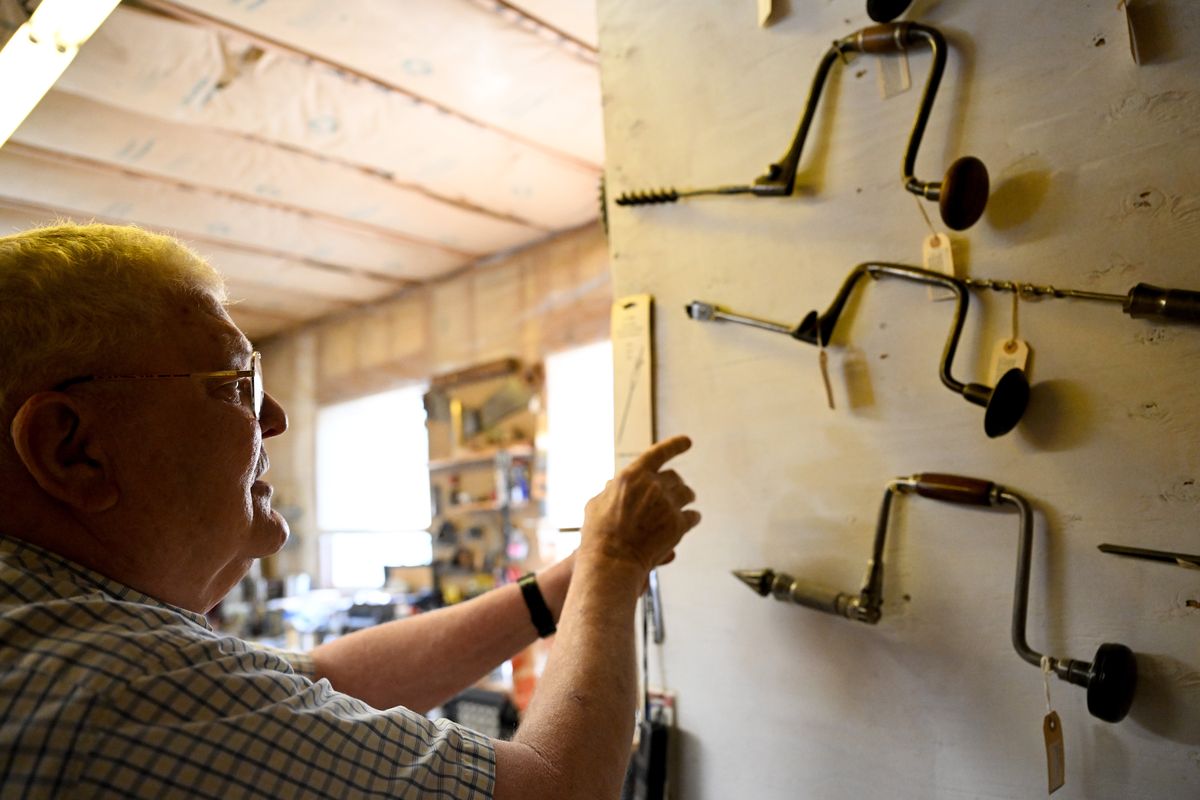The Collector: Harold Young: Antique planes were the beginning of handheld tool collection

A wooden box in Harold Young’s workshop holds the genesis of his collection.
In the mid-’80s, he and his wife went to Arizona to build wooden steps on his parent’s trailer. A neighbor came over and mentioned that he had some old wooden planes and tools and wondered if Young might be interested.
“We went to take a look, and the next thing I knew, we’d bought them,” Young said.
In addition to the planes, he got a cast iron rolling wheel used to measure distances.
“It’s called a ‘traveler’ and it’s pre-tape measure,” he said.
His appreciation for the antique tools grew when he tried to make the box to house his collection.
“My idea was to make it with all handheld tools,” said Young. “That lasted about 30 minutes. It was too hard and took too long!”
He didn’t start adding to his collection until he retired from the Navy and moved to Spokane in 1994.
Retirement allowed him to browse at garage sales, thrift shops and antique stores. Planes of all types became his passion.
“Each plane makes a specific design – a big or small groove or pattern,” he said. “A carpenter or cabinetmaker had to have a wide variety of planes. Plus, I think they’re kind of pretty.”
He has 100 planes, including 56 wooden planes, most from before the 1900s and made by the Ohio Tool Co.
Young has a special affection for his eight antique plow planes. A plow plane creates grooves by removing material from the middle of a piece of wood, leaving two outside edges. The plane has a guide or fence, which runs along the underside or outer edge of the body to keep the groove parallel.
Circular planes, also called compass planes appeal to him as well. He only has three because they’re relatively rare.
“They’re unique in that the sole flexes either way to allow the outside or the inside circumference to be planned,” said Young. “I understand it was used by wheelwrights to prepare the outer circumference of a wheel for the iron rim and the inside circumference to insert the spokes. It may have been used by finish carpenters making arched doorways and doors.”
His collection includes nine transitional planes with wooden bottoms and metal tops and 35 metal planes, most made before 1920 by the Stanley Tool Company.
One example was produced by Stanley from 1884-1962. The Stanley 45 originally came with 23 interchangeable cutters in two wooden boxes.
He believes his oldest plane is a 7/8-inch tongue plane made by A. & E. Baldwin of New York.
“They only made planes from 1830 to 1841 so the plane had to have been made during those 11 years,” he said.
A cousin gifted him with his priciest addition.
“It’s a Victor Bailey No. 20 circular plane valued between $300 and $500,” said Young. “It was made in 1880-1888 by Leonard Bailey’s Victor Co., which he sold to Stanley.”
Though he mostly collects woodworking tools, he laughed when asked if he uses any of them.
“I’m not a carpenter, I’m a wood butcher,” he said. “I make sawdust!”
And while he focused on planes, he picked up other tools along the way.
For example, a slotted screwdriver made by a blacksmith from an old wood rasp/file.
“They didn’t want to waste any steel.”
He also has several draw knives.
“They’ve looked like this since Egyptian times,” he said, pointing to one. “They’re used to debark logs of smooth beams.”
Part of the allure for Young is learning as much as he can about his collection. Each item is affixed with a tag that includes information about the manufacturer and approximate date of production.
“I had no idea what some of them were, I just knew they were old. I bought them and then did the research.”
He has shared his collection at church groups and at a retirement home group he led for several years.
“Some of the old guys would say, ‘My dad had one of those!’ ”
As he looked over the tools, he acknowledged most of the work they did could now be done by a table saw which lacks the allure of these old-fashioned instruments.
He marvels at the myriad of beautiful and practical things craftsmen created with such basic items.
“I look at the tools – they’re so well made and somewhat decorative,” Young said. “I appreciate the workmanship that went into them, but to use these to make a Chippendale is just beyond me!”